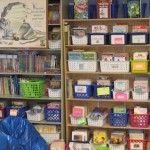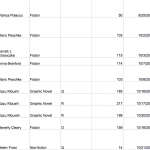It’s hard to believe that school is starting in 2 weeks! I know a lot of friends are back in school already, while a few (lucky) friends are still about 4 weeks away. There is much work ahead, but my favorite planning is around my 5th grade Independent Reading Workshop.
Reflecting on my past year – looking back to move forward — will help me revise and refine my structures. Several things I’ve learned:
- Kids did not have a strong enough sense of authors, genres, series, or titles in September. This makes “choice” very challenging.
- Many kids were lacking passions for books OR had one book or single reading experience that they keep going back to and didn’t quite know how to recreate that experience with other books.
- Most kids did not identify a favorite book or author in the beginning of the year.
- Many kids were not making enough time for reading once out of school
- Kids were mostly passive readers, expecting the book to do the work of reading, and not working up what Kathy Collins calls “brain sweat” while reading.
1. Kids did not have a strong enough sense of authors, genres, series, or titles in September. This makes “choice” very challenging.
At the beginning of the year, I give students reading surveys to get a handle on their habits, tastes, feelings, and experiences around reading. Some of these include the Garfield survey, the Title Recognition Test, and others that I have either made or collected throughout the years. I get a good baseline from this data, and use it to inform my initial reading conferences with students. I communicate my expectations for appropriate book choices the students need to make for themselves, and in order to choose well they need to know themselves as readers.
2. Many kids were lacking passions for books OR had one book or single reading experience that they keep going back to and didn’t quite know how to recreate that experience with other books. 3. Most kids did not identify a favorite book or author in the beginning of the year.
ALL kids know who Jeff Kinney is, whether they’ve read Diary of a Wimpy Kid or not! I think there is much to learn from this. With all due respect to Mr. Kinney, there are other authors and series out there! We (teachers) can “market” other books to our students and create a buzz around other books and authors that kids will like and want to be seen reading. This is important because reading in school is very social and children are highly aware of what everyone around them is reading. If they can feel excitement while reading a book once, we can help them learn how to take that experience and generalize it to new reading experiences. In fact, Stephen Krashen wrote about this here and referred to Jim Trelease’s idea of “the home run book:”
…a limited number of positive experiences with readingmay be enough to create a reader. Jim Trelease (personal communication) has infact suggested that one very positive experience can create a reader, one “home run”book.
It’s a lot of work to keep kids reading in just right books, and we want them digging in and having robust reading experiences. In my reading workshop, I am on high alert for students who are posing with their books, just kind of dozing or daydreaming with a book in their hands. Bad habits are harder to break than good ones are to form, so it is not acceptable to “pretend” read in 5th grade. While working with Kathy Collins in our school this year, I loved her idea of the author doing all of this work to write the book and it’s our job as a reader to have an active reading experience that makes our brains sweat a bit. Kids need to know that’s an expectation, and that it’s good for them! What are some ways you combat passive reading?
Partnership work helps make children accountable for their reading in authentic ways. I am excited to do more work around reading partnerships this year. I also had students writing me letters about their reading, as well as sharing comments in their googledocs logs with classmates.
Also, I cannot stress enough the importance of daily read aloud work with talk as an integral component of literacy instruction. I will be posting more about structures and routines on this component, as well as shared reading, as pieces of a balanced literacy framework.
So, for now I am busy planning and dreaming of the reading work that happens soon!



2 Comments
Leave a reply →